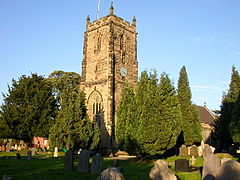Powerflush nearby to Bulkington
 Bulkington is a large village and former civil parish in Warwickshire, England, in the Nuneaton and Bedworth district. The ward had a population of 6,146 in the 2011 census and 6,303 in the 2001 census. It is about 6 miles (10 kilometres) northeast of Coventry, just east of Nuneaton and Bedworth, and 5 miles (8 kilometres) southwest of Hinckley. Despite its historical ties to Bedworth, Bulkington is now part of the Nuneaton Urban Area.
Bulkington is a large village and former civil parish in Warwickshire, England, in the Nuneaton and Bedworth district. The ward had a population of 6,146 in the 2011 census and 6,303 in the 2001 census. It is about 6 miles (10 kilometres) northeast of Coventry, just east of Nuneaton and Bedworth, and 5 miles (8 kilometres) southwest of Hinckley. Despite its historical ties to Bedworth, Bulkington is now part of the Nuneaton Urban Area.
Bulkington was first mentioned in the Domesday Book as Bochintone, which translates as “estate associated with a man named Bulca.” The parish originally had seven hamlets, two of which were absorbed by Bulkington village after residential development began in the 1930s. Ribbon weaving was historically the main industry in Bulkington. Bulkington is now primarily a commuter village for larger nearby urban areas such as Coventry, Nuneaton, Bedworth, Hinckley, and Leicester. Bulkington has ties to the locally born author George Eliot (Mary Ann Evans), who was a frequent visitor to the village. In her book Silas Marner, she is thought to have referred to it as Raveloe (1861). George Eliot’s uncle and aunt are buried in St James Church.
Click this page for powerflushing service in these postcode areas:
HISTORY
Medieval
Bulkington’s early history can be traced back to Domesday Book, where it is mentioned as one of the estates of the Count of Meulan, overseen by his sub-tenant Salo. Bulkington parish was originally divided into two five-hide vills: Bulkington and Barnacle in the south, and Marston, Weston, and Bramcote in the north. The Count of Meulan held the first four of these.
Bulkington was the largest of these sub-divisions (at 4 hides and 1 virgate) and served as the manor’s centre; however, by the late 13th century, the manor’s centre had shifted to Weston-in-Arden. Bulkington, Bramcote, Barnacle, Ryton, Clifton, and Wibtoft were all part of the Weston manor by 1285.
Weston Hall, a manor house dating from the 16th century, still stands in Weston-in-Arden. It was substantially renovated around 1892, and after a brief stint as a nightclub in the 1970s and 1980s, it now serves as a hotel.
The early modern era
Agriculture was the main source of income in Bulkington throughout the mediaeval period and until the late 18th century: 100 acres (0.40 km2) of meadowland were recorded in 1086, as were windmills in Weston and Marston Jabbett, as well as a water mill in Bramcote. However, in 1766, 700 acres (2.8 km2) of common land were enclosed at Ryton, and four years later, the remainder of the land in Bulkington was enclosed, totaling 1,600 acres (6.5 km2).
As a result, for the majority of Bulkington’s population, ribbon weaving supplemented or replaced agriculture as the primary source of income. This cottage industry had spread to Bulkington from the major cities of Coventry and Bedworth, where the Huguenots had introduced it in the 18th century. The late 18th and early 19th centuries saw significant growth in the village, with its population nearly tripling.
The introduction of factory production at Coventry, as well as competition from cheap imports, caused a slump in the industry in the 1830s. However, the 1840s saw another period of expansion, with many buildings being re-fronted or rebuilt in chequered brick work (characteristic of North Warwickshire buildings of the period).
“When the Cobden treaty with France removed the duty on French silks entering England,” the industry collapsed in the 1860s. This was accompanied by an agricultural depression, which resulted in a population drop of nearly a third by 1891. ‘On Thursday, 15 August 1861, six families comprising 27 members left for Quebec, Canada, as a result of the continued depression of the Ribbon trade…,’ according to the Bulkington Baptismal register, 1841–1861. At the same time, 83 houses in the parish were vacant. ‘Vicar Robert Potter.’
Nonetheless, ribbon production in Bulkington continued into the mid-twentieth century, albeit through small factory production rather than as a cottage industry. Arden Road’s last factory closed in the early 1950s.
The Trent Valley Line was built near the village in 1847, and Bulkington railway station opened in 1848. The station was decommissioned in 1931.

